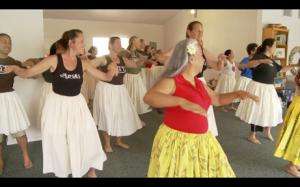Hula found to be a promising cardiac rehabilitation therapy

For the first time ever, researchers have determined the metabolic equivalent for hula in a study that shows the Native Hawaiian dance form can be an effective and engaging cardiac rehabilitation therapy.
Researchers from the University of Hawaii John A. Burns School of Medicine (JABSOM) and The Queen's Medical Center in Honolulu presented preliminary findings to the participants of the study on August 28, 2012.
The Hula Empowering Lifestyle Adaptations (HELA) study followed 60 participants, all of whom had suffered heart attack, heart failure or undergone heart surgery within two to 12 weeks before the study five-year research project began.
"The goal was to establish the measured metabolic rate of hula practice, and learn whether physicians might be able to prescribe hula as a cardiac rehabilitation therapy," said Mele Look, Director of Community Engagement for JABSOM's Department of Native Hawaiian Health. "What we found was that hula can match the cardiac workout of a pick-up basketball game."
While hula is known worldwide and deeply connected to Hawai'i's identity, Look noted, the HELA Study is the first time that hula has been scientifically evaluated as part of a health program. Heart disease is of particular concern for Native Hawaiians, whose heart disease death rates are almost twice other ethnic groups.
"Medical literature shows that heart attack victims who engage in cardiac rehabilitation can reduce their chance of death from another heart attack by as much as 56%," said Look. "Yet many people simply don't do it."
The researchers believe social support plays an important role in recovery from hospitalization for a major cardiac event, improving long-term survival and lowering the risk or rehospitalization.
The National Institutes of Health provided support for the study, which found:
- The level of energy expended dancing hula, among competitive hula dancers when dancing continuously, was found to be 6.6 MET, which is between a pick-up basketball game and a casual tennis match. High intensity dances of hula were measured in the range of a competitive basketball or volleyball game.
- Utilization of hula-based cardiac rehabilitation program was found, in preliminary results, to provide cardiopulmonary benefits similar to what is expected from a cardiac rehabilitation (CR).
- High levels of social support were created in the hula-based CR class. Participants reported improvement in mental and social well-being. They reported the cultural content enhanced the therapy and specifically that hula integrated mind, body, spirit and culture. The study found retention and attendance were very high for participants of the hula-based cardiac rehabilitation classes.















